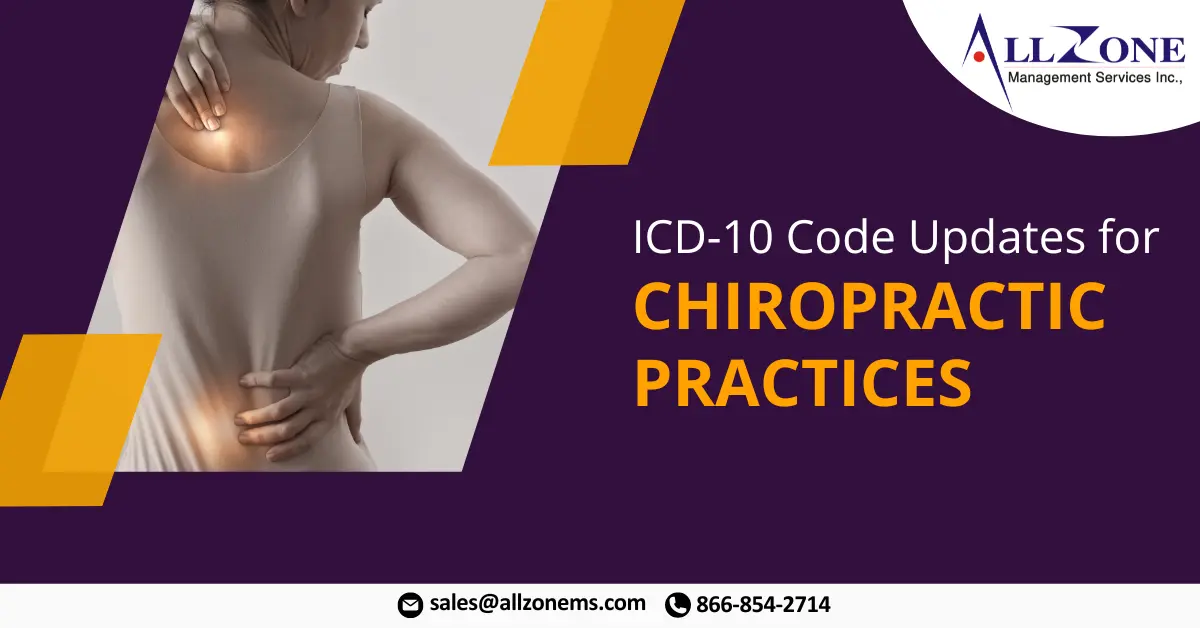Coding Best Practices
- Symptom vs. Diagnosis Codes: ICD-10 allows reporting of symptom and sign codes when a definitive diagnosis has not been established. However, when a specific diagnosis is supported by documentation, it should be reported instead.
- Uncertain Diagnoses: Do not code diagnoses labeled as “probable,” “suspected,” “questionable,” “rule out,” or “working diagnosis.” Instead, report the most certain condition for that visit, such as symptoms, abnormal test results, or reasons for the encounter.
- Comprehensive Documentation: Providers must fully describe each encounter and report only the diagnoses actively addressed during the visit. Contributory conditions should also be documented clearly in the patient record.
Key 2025 ICD-10 Code Updates for Chiropractic Practices
New ICD-10 Codes for Lumbar Disc Degeneration
The M51.36 code (five-digit) has been replaced with six-digit codes:
- M51.360 – Other intervertebral disc degeneration, lumbar region with discogenic (axial) back pain only
- M51.361 – Other intervertebral disc degeneration, lumbar region with lower extremity pain (leg pain with referred sclerotomal pain) only
- M51.362 – Other intervertebral disc degeneration, lumbar region with discogenic (axial) back pain and lower extremity pain
- M51.369 – Other intervertebral disc degeneration, lumbar region without mention of lumbar back pain or lower extremity pain
New ICD-10 Codes for Lumbosacral Disc Degeneration
The M51.37 code (five-digit) has been replaced with six-digit codes:
- M51.370 – Other intervertebral disc degeneration, lumbosacral region with discogenic (axial) back pain only
- M51.371 – Other intervertebral disc degeneration, lumbosacral region with lower extremity pain only
- M51.372 – Other intervertebral disc degeneration, lumbosacral region with discogenic back pain and lower extremity pain
- M51.379 – Other intervertebral disc degeneration, lumbosacral region without mention of back pain or lower extremity pain
New Terminology Definitions
- Discogenic pain: Back pain originating in the intervertebral disc, often due to degenerative changes.
- Axial back pain: Pain localized to the lower back region.
- Sclerotomal pain: Deep, dull pain radiating along a sclerotome.
Additional 2025 ICD-10 Code Updates
Low Back Muscle Dysfunction
- M62.85 – Dysfunction of the multifidus muscles, lumbar region
New Shoulder ICD-10 Codes
- M65.90 – Unspecified synovitis and tenosynovitis, unspecified site
- M65.91 – M65.919 – Unspecified synovitis and tenosynovitis, shoulder (right, left, unspecified)
New ICD-10 Codes for Upper Arm, Forearm, Hand, Thigh, Lower Leg, Ankle & Foot
New codes have been introduced to classify unspecified synovitis and tenosynovitis across multiple body regions, including:
- Upper Arm (M65.92 – M65.929)
- Forearm (M65.93 – M65.939)
- Hand (M65.94 – M65.949)
- Thigh (M65.95 – M65.959)
- Lower Leg (M65.96 – M65.969)
- Ankle and Foot (M65.97 – M65.979)
Understanding ICD-10 Coding Rules
Trauma Episodes of Care
ICD-10 designates trauma-related encounters using the following letter suffixes:
- A – Initial Encounter: Active treatment for the condition.
- D – Subsequent Encounter: Follow-up care after treatment by another provider.
- S – Sequela: Late effect or complication from the original condition.
For sequela codes, both the original injury code and the sequela code must be reported, with “S” added only to the injury code.
ICD-10 Code Bundling & Excludes 1 Notes
Some health plans deny claims based on Excludes 1 notes, which indicate that two conditions cannot be reported together.
Examples of Excludes 1 Denials
- M54.50 (Low back pain) cannot be reported with M54.41 (Sciatica with low back pain, right side) or M54.42 (left side).
- M54.50 (Low back pain) cannot be reported with S39.012 (Strained muscles of the lower back).
- M51.16 (Lumbar disc disorder with radiculopathy) cannot be reported with M54.16 (Lumbar radiculopathy).
- M54.2 (Neck pain) cannot be reported with M50.122 (Cervical disc disorder with radiculopathy at C5-C6).
- M54.6 (Thoracic pain) cannot be reported with M51.34 (Thoracic disc degeneration).
If both codes are submitted together, a denial may occur.
Final Thoughts
For chiropractors and musculoskeletal specialists, staying updated on Code Updates for Chiropractic Practices and ICD-10 coding changes is essential for accurate diagnosis coding and reimbursement.
To ensure compliance:
- Schedule training sessions for DCs and staff.
- Log training details for billing and coding compliance.
- Review patient records for complete and precise documentation.
By following these best practices, providers can improve claim accuracy, reduce denials, and optimize reimbursement under the 2025 ICD-10 guidelines.
Streamlining Chiropractic Practices with Expert Billing Services
Chiropractic billing services are essential for chiropractic practices aiming to streamline their operations, improve accuracy, and maximize reimbursement. By partnering with a specialized chiropractic billing company, practices can benefit from reduced administrative burdens, enabling them to focus on patient care and overall practice growth. These services ensure proper coding for chiropractic procedures, such as spinal manipulations and therapeutic exercises, ensuring compliance with insurance guidelines and avoiding costly claim denials.
Chiropractic billing companies have expert knowledge in navigating complex payer requirements, which can vary from state to state and insurer to insurer. This expertise, along with staying updated on Code Updates for Chiropractic Practices, results in faster claim processing, timely reimbursements, and improved revenue cycles. Furthermore, outsourcing billing allows chiropractors to save time and resources, as they don’t need to invest in staff training or billing software.
In summary, chiropractic billing services offer chiropractic practices improved cash flow, efficiency, and compliance, all contributing to enhanced patient satisfaction and business success.

